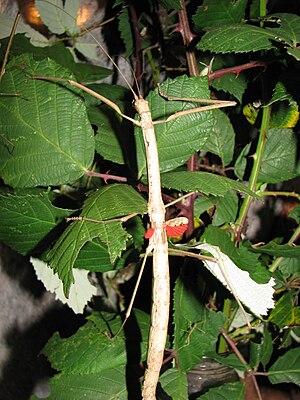Phaenopharos
| Phaenopharos | ||||||||||||
|---|---|---|---|---|---|---|---|---|---|---|---|---|

Female of the red-winged Phaenopharos |
||||||||||||
| Systematics | ||||||||||||
|
||||||||||||
| Scientific name | ||||||||||||
| Phaenopharos | ||||||||||||
| Kirby , 1904 |

Phaenopharos is a genus of the stick insects - Family Diapheromeridae .
morphology
The representatives of the genus Phaenopharos show the typical stick insect habitus . Their wings are always greatly reduced. While the forewings are completely absent or can just barely be seen as scale-shaped tegmina , the rear wings, barely one centimeter long, have a bright red anal field , which is hidden under the heavily sclerotized costal field . This is matched in color to the beige, brown or gray and white speckled body. The expression of the wing rudiments is relevant for differentiating the three types described so far. Depending on the species, females reach a body length between 14 and 16 cm. Males, as far as they are known, remain significantly smaller at 9 to 11 cm and are much slimmer than the approximately pencil-thick females.
Systematics
The genus was established in 1904 by William Forsell Kirby , who transferred the species already described by John Obadiah Westwood as Lopaphus struthioneus in 1859 to this genus. The genus Chersaeus , established by Ludwig Redtenbacher in 1908, is synonymous with Phaenopharos . The following three types are currently known:
- Unwedded Phaenopharos ( Phaenopharos herwaardeni Hennemann , Conle & Bruckner , 1996) - it lacks any forewing remains , hind wings with a red anal field are present
- Red-winged Phaenopharos ( Phaenopharos khaoyaiensis Zompro , 2000) - scale-shaped fore wing rudiments and hind wings with a red anal field developed
- Red-black winged Phaenopharos ( Phaenopharos struthioneus ( Westwood , 1859)) - has scaly fore wing rudiments and hind wings with black veins on the otherwise red anal field
Occurrence and behavior
The wingless and red winged Phaenopharos come from Thailand . Here Phaenopharos herwaardeni was found in higher elevations of the Khao-Yai National Park , while Phaenopharos khaoyaiensis comes from lower regions of the same area. Phaenopharos struthioneus is native to Malaysia , Singapore, and Sumatra .
In addition to the autotomy known from many stick insects and the motionless remaining in a stretched position for the best possible phytomimesis , all species react when alarmed by opening the hind wings, whereby the bright red anal fields can be seen.
Keeping in the terrarium
All three species can be found in the terrariums of horror aficionados. The Phaenopharos herwaardeni, managed by the Phasmid Study Group under PSG number 104, and the Phaenopharos khaoyaiensis (PSG number 215), which is only cultivated as a parthenogenetic breeding line, are considered to be relatively easy to care for. Phaenopharos struthioneus (PSG number 205) is considered a bit more demanding.
swell
- ↑ a b c Seiler, Bradler, Koch: Phasmids - care and breeding of ghosts, stick insects and walking leaves in the terrarium - bede, Ruhmannsfelden 2000, ISBN 3-933646-89-8
- ↑ a b c d Ingo Fritzsche : Poles - Carausius, Sipyloidea & Co. , Natur und Tier Verlag, Münster 2007, ISBN 978-3-937285-84-9
- ^ Paul D. Brock : Phasmida Species File Online . Version 2.1 / 3.5. (accessed June 14, 2009) http://Phasmida.SpeciesFile.org
- ↑ www phasmida myspecies - Phasmid Study Group Culture List (Engl.)